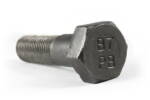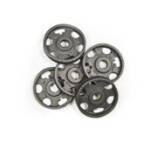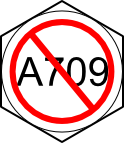ASTM FAQs
Fully Threaded A490s
Can ASTM A490 heavy hex structural bolts be fully threaded?2015 Update: Yes, ASTM A490 bolts can now be fully threaded. There is a supplemental provision in the F3125 specification that allows the bolt to be fully threaded as long as it is stamped with an “S”. The A490 specification starts at ½” diameter and stops at 1-1/2” diameter, and each diameter has its own specific thread length... Read more

Fastener Marking Requirements
What are the product marking requirements for bolts?Headed bolts are required to be stamped on top of the head, while most rods and some bent bolts are required to be stamped on one end. This Fastener Identification Markings Chart shows the various marking requirements for most common grades of ASTM and SAE fasteners. Headed Bolts ASTM specifications require a manufacturer’s identification and... Read more
A320 Head Requirements
Does A320 require bolts or cap screws to have heavy hex heads?Your page says A320 requires bolts or cap screws to have heavy hex heads. I have the 2003 edition of A320 and can’t find that requirement. Where is that requirement stated? The ASTM A320 specification does not specifically address the physical dimensions of headed bolts. However, it does refer you to ASTM A962 for some... Read more
A325 Countersunk Bolts
Can Portland Bolt manufacture A325 countersunk bolts?The short answer is, yes! In 2015, ASTM created F3125 which is a new, all-inclusive specification for structural bolts that consolidated and replaced the following six stand-alone ASTM standards: A325, A325M, A490, A490M, F1852 and F2280. Under the new F3125 specification, A325 fasteners can be made in head styles other than heavy hex as long... Read more
ASTM Revision Letters
What do the letters and numbers after ASTM grades mean?ASTM standards are typically called out by their ASTM number and year of revision, for example F1554-07. Occasionally, when small revisions are made at ASTM that do not necessitate a full year revision, the year is annotated with a letter. We fielded a chat recently where this question came up. Below is the correspondence and... Read more

ASTM Specifications for Castings
What ASTM Specification covers castings?There are several ASTM specs which cover castings, including A47, A48, A536, and A668. ASTM A47 A47 covers malleable castings intended for general use up to temperatures around 750⁰ Fahrenheit. A47 castings come in one grade, available in metric and imperial. Common forgings specified to A47: Shear Plates, Beveled Washers ASTM A48 A48 covers gray... Read more
F1554-55 vs F1554-36
Can an F1554 Grade 55 anchor bolt be substituted for an F1554 Grade 36 anchor bolt?Yes. According to ASTM F1554-15 when Grade 36 is specified, a weldable Grade 55 may be furnished at the supplier’s option. F1554 Grade 36 vs. F1554 Grade 55 F1554 is the ASTM specification for fasteners that have an intended use for anchoring structural supports to concrete foundations. The specification is available in three strength grades:... Read more

ASTM A709 Grade 36 Bolts
Can I order bolts to ASTM A709 Grade 36?The simple answer here is no. ASTM A709 is a specification that covers carbon and high-strength structural steel plates and bars intended for use in bridge applications. There are multiple grades of A709 and Grade 36 covers the structural steel made from mild carbon steel, such as A36. Although Portland Bolt would manufacture an A709 Grade... Read more
F1554 Anchor Bolt Tolerances
What are the tolerances for F1554 anchor bolts?In our Live Chat, numerous customers have asked us about tolerances under the F1554 specification relating to things like diameter, length, straightness, and many other parameters. While a customer always has the option of specifying a particular set of tolerances they may require for any bolt, what are the default tolerances for anchor bolts under... Read more
ASTM A193 B7 vs. A193 B7M
What is the difference between A193 Grade B7 & A193 Grade B7M?Several ASTM specifications are followed by an “M” that denotes it being an equivalent metric standard. While there is actually an A193M Grade B7 specification which is applicable to metric fasteners, this is not the case with ASTM A193 Grade B7M. This is a different grade of material than A193 Grade B7. So how exactly... Read more
